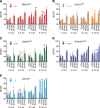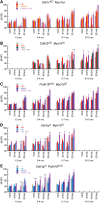Digenic inheritance of deafness caused by 8J allele of myosin-VIIA and mutations in other Usher I genes
- PMID: 22381527
- PMCID: PMC3349429
- DOI: 10.1093/hmg/dds084
Digenic inheritance of deafness caused by 8J allele of myosin-VIIA and mutations in other Usher I genes
Abstract
Inherited hearing loss in mice has contributed substantially to our understanding of inner-ear function. We identified a new allele at the Myo7a locus, Myo7a(sh1-8J); genomic characterization indicated that Myo7a(sh1-8J) arose from complex deletion encompassing exons 38-40 and 42-46. Homozygous mutant mice had no detectable auditory brainstem response, displayed highly disorganized hair-cell stereocilia and had no detectable MYO7A protein. We generated mice that were digenic heterozygotes for Myo7a(sh1-8J) and one of each Cdh23(v-2J), Ush1g(js) or Pcdh15(av-3J) alleles, or an Ush1c null allele. Significant levels of age-related hearing loss were detected in +/Myo7a(sh1-8J) +/Ush1g(js), +/Myo7a(sh1-8J) +/Cdh23(v-2J) and +/Myo7a(sh1-8J) +/Pcdh15(av-3J) double heterozygous mice compared with age-matched single heterozygous animals, suggesting epistasis between Myo7a and each of the three loci. +/Pcdh15(av-3J) +/Ush1g(js) double heterozygous mice also showed elevated hearing loss, suggesting Pcdh15-Ush1g epistasis. While we readily detected MYO7A, USH1C, CDH23 and PCDH15 using mass spectrometry of purified chick utricle hair bundles, we did not detect USH1G. Consistent with that observation, Ush1g microarray signals were much lower in chick cochlea than those of Myo7a, Ush1c, Cdh23 and Pcdh15 and were not detected in the chick utricle. These experiments confirm the importance of MYO7A for the development and maintenance of bundle function and support the suggestion that MYO7A, USH1G (Sans) and CDH23 form the upper tip-link complex in adult mice, likely in combination with USH1C (harmonin). MYO7A, USH1G and PCDH15 may form another complex in stereocilia. USH1G may be a limiting factor in both complexes.
Figures






Similar articles
-
Stereocilia defects in waltzer (Cdh23), shaker1 (Myo7a) and double waltzer/shaker1 mutant mice.Hear Res. 2002 Jul;169(1-2):13-23. doi: 10.1016/s0378-5955(02)00334-9. Hear Res. 2002. PMID: 12121736
-
Heterozygous mutation of Ush1g/Sans in mice causes early-onset progressive hearing loss, which is recovered by reconstituting the strain-specific mutation in Cdh23.Hum Mol Genet. 2016 May 15;25(10):2045-2059. doi: 10.1093/hmg/ddw078. Epub 2016 Mar 2. Hum Mol Genet. 2016. PMID: 26936824
-
Analysis of subcellular localization of Myo7a, Pcdh15 and Sans in Ush1c knockout mice.Int J Exp Pathol. 2011 Feb;92(1):66-71. doi: 10.1111/j.1365-2613.2010.00751.x. Epub 2010 Dec 13. Int J Exp Pathol. 2011. PMID: 21156003 Free PMC article.
-
The molecular genetics of Usher syndrome.Clin Genet. 2003 Jun;63(6):431-44. doi: 10.1034/j.1399-0004.2003.00109.x. Clin Genet. 2003. PMID: 12786748 Review.
-
Unconventional myosins and the genetics of hearing loss.Am J Med Genet. 1999 Sep 24;89(3):147-57. doi: 10.1002/(sici)1096-8628(19990924)89:3<147::aid-ajmg5>3.0.co;2-6. Am J Med Genet. 1999. PMID: 10704189 Review.
Cited by
-
Digenic inheritance in medical genetics.J Med Genet. 2013 Oct;50(10):641-52. doi: 10.1136/jmedgenet-2013-101713. Epub 2013 Jun 19. J Med Genet. 2013. PMID: 23785127 Free PMC article. Review.
-
Genotype Characterization and MiRNA Expression Profiling in Usher Syndrome Cell Lines.Int J Mol Sci. 2024 Sep 17;25(18):9993. doi: 10.3390/ijms25189993. Int J Mol Sci. 2024. PMID: 39337481 Free PMC article.
-
Functional, Morphological, and Evolutionary Characterization of Hearing in Subterranean, Eusocial African Mole-Rats.Curr Biol. 2020 Nov 16;30(22):4329-4341.e4. doi: 10.1016/j.cub.2020.08.035. Epub 2020 Sep 3. Curr Biol. 2020. PMID: 32888484 Free PMC article.
-
Spontaneous allelic variant in deafness-blindness gene Ush1g resulting in an expanded phenotype.Genes Brain Behav. 2023 Aug;22(4):e12849. doi: 10.1111/gbb.12849. Epub 2023 Jun 16. Genes Brain Behav. 2023. PMID: 37328946 Free PMC article.
-
Molecular genetic landscape of hereditary hearing loss in Pakistan.Hum Genet. 2022 Apr;141(3-4):633-648. doi: 10.1007/s00439-021-02320-0. Epub 2021 Jul 25. Hum Genet. 2022. PMID: 34308486 Review.
References
-
- Richardson G.P., de Monvel J.B., Petit C. How the genetics of deafness illuminates auditory physiology. Annu. Rev. Physiol. 2011;73:311–334. - PubMed
-
- Hasson T., Walsh J., Cable J., Mooseker M.S., Brown S.D., Steel K.P. Effects of shaker-1 mutations on myosin-VIIa protein and mRNA expression. Cell Motil. Cytoskeleton. 1997;37:127–138. - PubMed
-
- Self T., Mahony M., Fleming J., Walsh J., Brown S.D., Steel K.P. Shaker-1 mutations reveal roles for myosin VIIA in both development and function of cochlear hair cells. Development. 1998;125:557–566. - PubMed
-
- Kros C.J., Marcotti W., van N.S.M., Self T.J., Libby R.T., Brown S.D., Richardson G.P., Steel K.P. Reduced climbing and increased slipping adaptation in cochlear hair cells of mice with Myo7a mutations. Nat. Neurosci. 2002;5:41–47. - PubMed
Publication types
MeSH terms
Substances
Associated data
- Actions
Grants and funding
LinkOut - more resources
Full Text Sources
Medical
Molecular Biology Databases

